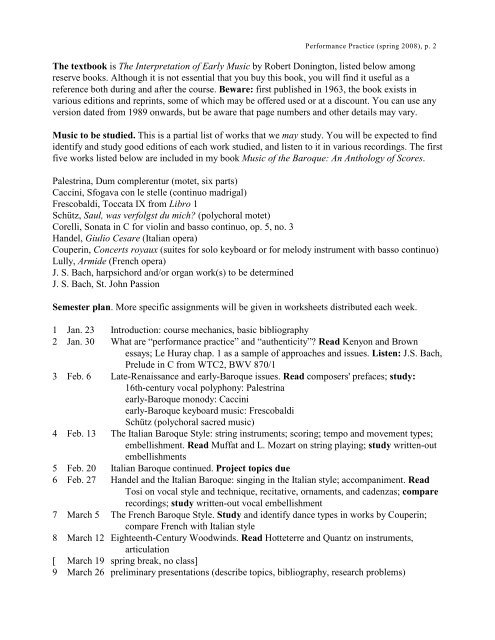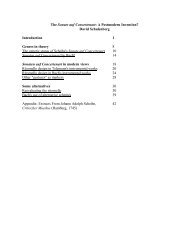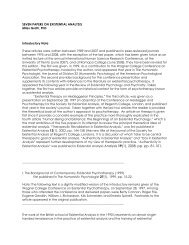Historical Performance Practice of European Art Music Class ...
Historical Performance Practice of European Art Music Class ...
Historical Performance Practice of European Art Music Class ...
Create successful ePaper yourself
Turn your PDF publications into a flip-book with our unique Google optimized e-Paper software.
<strong>Performance</strong> <strong>Practice</strong> (spring 2008), p. 2<br />
The textbook is The Interpretation <strong>of</strong> Early <strong>Music</strong> by Robert Donington, listed below among<br />
reserve books. Although it is not essential that you buy this book, you will find it useful as a<br />
reference both during and after the course. Beware: first published in 1963, the book exists in<br />
various editions and reprints, some <strong>of</strong> which may be <strong>of</strong>fered used or at a discount. You can use any<br />
version dated from 1989 onwards, but be aware that page numbers and other details may vary.<br />
<strong>Music</strong> to be studied. This is a partial list <strong>of</strong> works that we may study. You will be expected to find<br />
identify and study good editions <strong>of</strong> each work studied, and listen to it in various recordings. The first<br />
five works listed below are included in my book <strong>Music</strong> <strong>of</strong> the Baroque: An Anthology <strong>of</strong> Scores.<br />
Palestrina, Dum complerentur (motet, six parts)<br />
Caccini, Sfogava con le stelle (continuo madrigal)<br />
Frescobaldi, Toccata IX from Libro 1<br />
Schütz, Saul, was verfolgst du mich? (polychoral motet)<br />
Corelli, Sonata in C for violin and basso continuo, op. 5, no. 3<br />
Handel, Giulio Cesare (Italian opera)<br />
Couperin, Concerts royaux (suites for solo keyboard or for melody instrument with basso continuo)<br />
Lully, Armide (French opera)<br />
J. S. Bach, harpsichord and/or organ work(s) to be determined<br />
J. S. Bach, St. John Passion<br />
Semester plan. More specific assignments will be given in worksheets distributed each week.<br />
1 Jan. 23 Introduction: course mechanics, basic bibliography<br />
2 Jan. 30 What are “performance practice” and “authenticity”? Read Kenyon and Brown<br />
essays; Le Huray chap. 1 as a sample <strong>of</strong> approaches and issues. Listen: J.S. Bach,<br />
Prelude in C from WTC2, BWV 870/1<br />
3 Feb. 6 Late-Renaissance and early-Baroque issues. Read composers' prefaces; study:<br />
16th-century vocal polyphony: Palestrina<br />
early-Baroque monody: Caccini<br />
early-Baroque keyboard music: Frescobaldi<br />
Schütz (polychoral sacred music)<br />
4 Feb. 13 The Italian Baroque Style: string instruments; scoring; tempo and movement types;<br />
embellishment. Read Muffat and L. Mozart on string playing; study written-out<br />
embellishments<br />
5 Feb. 20 Italian Baroque continued. Project topics due<br />
6 Feb. 27 Handel and the Italian Baroque: singing in the Italian style; accompaniment. Read<br />
Tosi on vocal style and technique, recitative, ornaments, and cadenzas; compare<br />
recordings; study written-out vocal embellishment<br />
7 March 5 The French Baroque Style. Study and identify dance types in works by Couperin;<br />
compare French with Italian style<br />
8 March 12 Eighteenth-Century Woodwinds. Read Hotteterre and Quantz on instruments,<br />
articulation<br />
[ March 19 spring break, no class]<br />
9 March 26 preliminary presentations (describe topics, bibliography, research problems)















